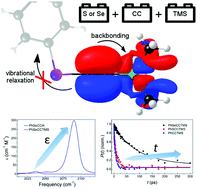Simultaneous enhancement of transition dipole strength and vibrational lifetime of an alkyne IR probe via π-d backbonding and vibrational decoupling†
Abstract
Alkyne infrared (IR) probes 1–6 with Si and S (or Se) atoms incorporated into the C![[triple bond, length as m-dash]](https://www.rsc.org/images/entities/char_e002.gif) C bond were synthesized, and the vibrational properties of their C
C bond were synthesized, and the vibrational properties of their C![[triple bond, length as m-dash]](https://www.rsc.org/images/entities/char_e002.gif) C stretch mode were studied using Fourier transform infrared (FTIR) and femtosecond IR pump–probe (IR PP) spectroscopies in combination with quantum chemical calculations. From FTIR studies, the transition dipole strengths (in units of 10−2 D2) of 1–3 having the Si atom were measured to be 1.85, 3.32, and 2.52, whereas those of 4–6 having no Si atom were measured to be 0.13, 0.20, and 0.17, respectively, in CHCl3. Thus, the increase in the transition dipole strength of the C
C stretch mode were studied using Fourier transform infrared (FTIR) and femtosecond IR pump–probe (IR PP) spectroscopies in combination with quantum chemical calculations. From FTIR studies, the transition dipole strengths (in units of 10−2 D2) of 1–3 having the Si atom were measured to be 1.85, 3.32, and 2.52, whereas those of 4–6 having no Si atom were measured to be 0.13, 0.20, and 0.17, respectively, in CHCl3. Thus, the increase in the transition dipole strength of the C![[triple bond, length as m-dash]](https://www.rsc.org/images/entities/char_e002.gif) C stretch mode upon incorporation of the Si atom into the C
C stretch mode upon incorporation of the Si atom into the C![[triple bond, length as m-dash]](https://www.rsc.org/images/entities/char_e002.gif) C bond is by a factor of about 14 or higher. The large increase in the transition dipole strength of the C
C bond is by a factor of about 14 or higher. The large increase in the transition dipole strength of the C![[triple bond, length as m-dash]](https://www.rsc.org/images/entities/char_e002.gif) C stretch mode upon such Si incorporation is attributed to π-d backbonding between the C
C stretch mode upon such Si incorporation is attributed to π-d backbonding between the C![[triple bond, length as m-dash]](https://www.rsc.org/images/entities/char_e002.gif) C group's π and Si atom's d orbitals. From IR PP experiments, the vibrational lifetimes of the C
C group's π and Si atom's d orbitals. From IR PP experiments, the vibrational lifetimes of the C![[triple bond, length as m-dash]](https://www.rsc.org/images/entities/char_e002.gif) C stretch mode in 1–3 having none, S, and Se atoms were determined to be 5.7 ± 0.7, 13.0 ± 1.1, and 94.2 ± 5.8 ps, respectively, in CHCl3. Thus, the increase in the vibrational lifetime of the C
C stretch mode in 1–3 having none, S, and Se atoms were determined to be 5.7 ± 0.7, 13.0 ± 1.1, and 94.2 ± 5.8 ps, respectively, in CHCl3. Thus, the increase in the vibrational lifetime of the C![[triple bond, length as m-dash]](https://www.rsc.org/images/entities/char_e002.gif) C stretch mode upon incorporation of the S (or Se) atom between the phenyl ring and the C
C stretch mode upon incorporation of the S (or Se) atom between the phenyl ring and the C![[triple bond, length as m-dash]](https://www.rsc.org/images/entities/char_e002.gif) C bond is by a factor of about 2 (or 16) or higher. The large increase in the vibrational lifetime of the C
C bond is by a factor of about 2 (or 16) or higher. The large increase in the vibrational lifetime of the C![[triple bond, length as m-dash]](https://www.rsc.org/images/entities/char_e002.gif) C stretch mode upon such S (or Se) incorporation is attributed to its heavy atom effect impeding vibrational couplings between the C
C stretch mode upon such S (or Se) incorporation is attributed to its heavy atom effect impeding vibrational couplings between the C![[triple bond, length as m-dash]](https://www.rsc.org/images/entities/char_e002.gif) C stretch and phenyl ring vibrations. From two-dimensional infrared (2DIR) experiments, the large transition dipole strength and long vibrational lifetime of 3 containing the Si and S (or Se) atoms were shown to enable the measurement of its 2DIR spectra up to 500 ps. The strongly absorbing alkynes with long vibrational lifetimes will be a promising probe of molecular dynamics in nonlinear vibrational spectroscopy and imaging on an extended time scale.
C stretch and phenyl ring vibrations. From two-dimensional infrared (2DIR) experiments, the large transition dipole strength and long vibrational lifetime of 3 containing the Si and S (or Se) atoms were shown to enable the measurement of its 2DIR spectra up to 500 ps. The strongly absorbing alkynes with long vibrational lifetimes will be a promising probe of molecular dynamics in nonlinear vibrational spectroscopy and imaging on an extended time scale.

- This article is part of the themed collection: 2019 PCCP HOT Articles


 Please wait while we load your content...
Please wait while we load your content...